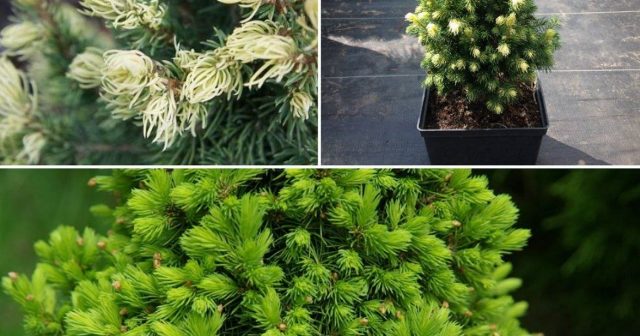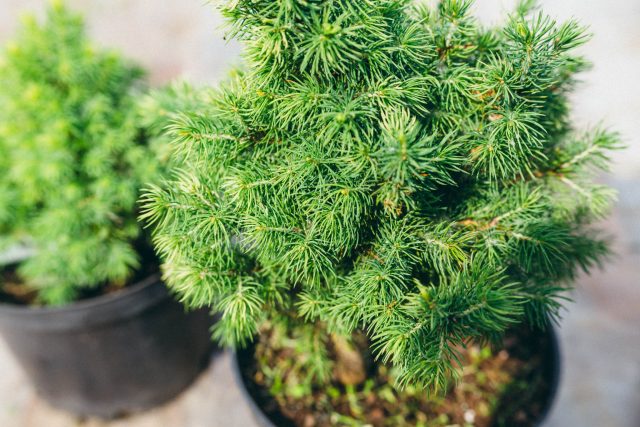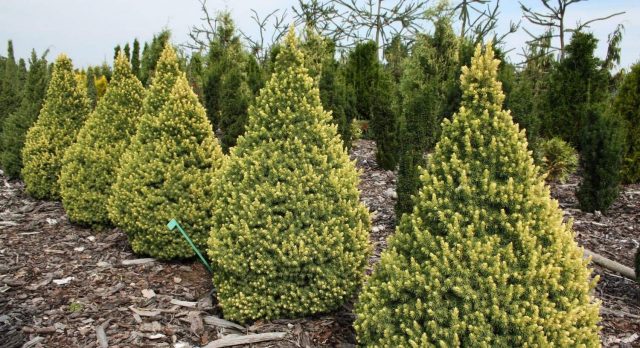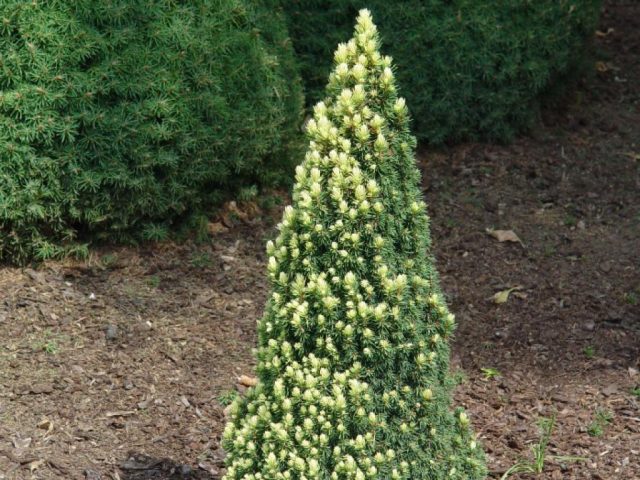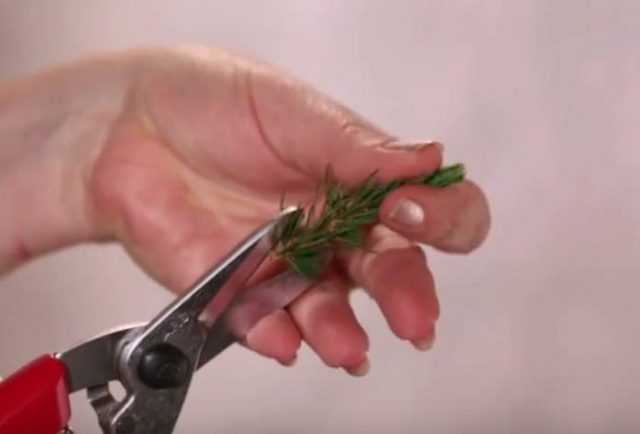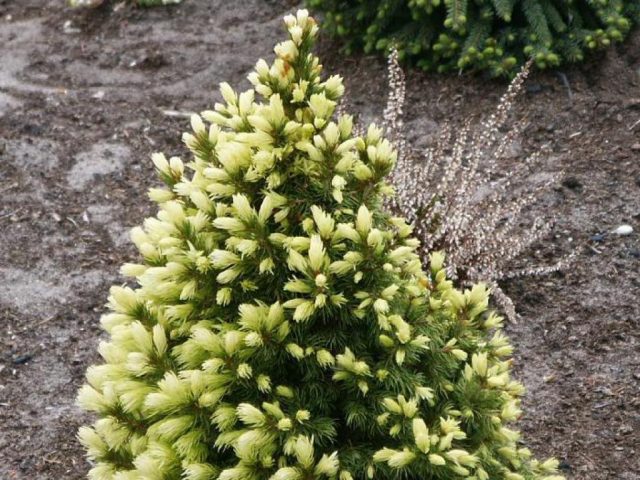Content
Canadian Spruce Rainbow End was obtained from a random mutation of Konica by a selection method conducted by Don Homemaw at Iseli Nursery (Bourning, Oregon). In 1978, the work was completed, and the new variety was presented to the public. Rainbow End is similar to the parental form, but grows more slowly and differs in the color of the needles in spring and mid-summer.
Description spruce Canadian Rainbow End
At 10 years old, the Canadian Rainbow End spruce reaches a height of 90 to 180 cm with a crown diameter of 40-60 cm.The annual growth is 7-10 cm.It is assumed that the tree can live up to 50 years, its maximum size is 2.5 m, sometimes 3m.
The crown of the Canadian spruce Rainbow End is very dense due to short internodes, regular shape, conical with a sharp crown. Over time, the contours are not as clear as at a young age. The branches of the spruce are directed upwards and are densely covered with needles, the length of which ranges from 1-1.5 cm.
Young growth is creamy, by summer it becomes golden yellow. Then the needles gradually change color to green. In partial shade, the color of the needles of the Canadian Rainbow End spruce is not too bright. If the tree gets very little sunlight, the yellow color appears weakly.
In the photo of the Canadian Randbows End spruce, you can clearly see the beautiful color of young needles.
At first, the needles are soft, then they become prickly and more rigid. If you rub the needles with your fingers, they give off a smell similar to blackcurrant.
The root system is located close to the soil surface. There are practically no cones.
Use in landscape design
Due to its dwarf size, beautiful crown shape and original color, the Canadian Rainbow End spruce quickly gained popularity. It is often used in small areas, where it is planted in flower beds, rockeries, rabatki and rock gardens.
The same small growth does not allow the Rainbow End spruce to be used as a tapeworm (single focal plant). In addition, in the open sun, the needles burn out from the south side. This feature should be taken into account when placing the variety and planting the spruce under the cover of plants that can protect it at noon.
Rainbow End looks good in the foreground of landscape groups, in regular plantings around the perimeter of the parterre lawn. It will decorate walking paths or the front entrance to the house, planted as a repeating element in long narrow flower beds.
Rainbow End Canadian Spruce can be placed in containers. This is convenient, since they are easy to carry from place to place, decorating as needed a place of rest or reception of guests, the entrance to the house. Only you need to care for the spruce planted in a pot carefully, and not let the earthy coma dry out.
Planting and caring for Rainbow End spruce
Actually, there is nothing special in the care of the Canadian Rainbow End spruce. It is important to carefully choose a place for the tree and plant it according to all the rules.
Seedling and planting plot preparation
Rainbow End Canada Spruce can grow in full sun and partial shade. But if in the summer in the middle of the day direct rays fall on it, the needles will burn and may crumble.In spring and autumn, the sun is not so active as to damage the tree, but starting in February it reflects and intensifies snow, and the spruce needs to be covered with burlap or non-woven cloth.
In the dense shade, the creamy and yellow color of young needles fades. After 10 years, sunburns do not significantly harm the health of the tree, but reduce its decorative effect. Rainbow End Canadian spruce is best planted in light partial shade, or covered from the southern side by plants with an openwork crown or leaves. Then the yellow color of the young growth will appear, and the needles will not burn.
For planting Canadian spruce, drained, moist soil with an acidic or slightly acidic reaction is suitable. It is best if it is moderately fertile loam or sandy loam. Why is the composition of the soil so important if it is recommended to completely change the soil in the planting pit? The fact is that the spruce root system is located in the upper layers of the soil and eventually spreads far beyond the crown perimeter. And no one will dig a pit on the site in order to plant a tiny slow-growing tree.
Canadian spruce Rainbow End endures short-term waterlogging of the soil in spring or after prolonged rains. But with constant waterlogging or close standing of groundwater, it will not be able to survive. Much worse than waterlogging, Canadian spruce tolerates dry soil.
A Rainbow End seedling from a foreign nursery must be purchased in a container. Even if the root is sheathed with burlap, there is no guarantee that during transportation someone was taking care of maintaining the water regime. With an open root dipped in a chatterbox and wrapped in cling film, Canadian spruce can be bought only if the tree was dug up in the presence of the future owner.
Landing rules
Container-grown Canadian spruces can be planted throughout the season, only in the south it is worth refraining from this during the hot summer months. But autumn is considered the best time. In warm regions, conifers are planted throughout the winter. In the North and the Urals, even the planting of fir trees with an open or burlap root can be postponed to spring.
The size of the pit for the Rainbow End should be as follows:
- diameter - not less than 60 cm;
- depth - at least 70 cm.
The drainage layer is made about 20 cm, the planting mixture is made up of sod land, leaf humus, sour peat, sand and clay. As a starting fertilizer, take 100-150 g of nitroammophoska.
The planting hole is 2/3 filled with the prepared mixture and filled with water. After 2 weeks, you can start planting the Canadian Rainbow End spruce:
- So much soil is taken out of the pit so that the root collar of the seedling installed in the center is flush with the ground.
- The soil is compacted during the filling of the pit so that voids do not form.
- Check the position of the root collar.
- A roller is formed around the planting pit from the remaining soil.
- Water the Canadian Rainbow End spruce abundantly so that the trunk circle is filled with water.
- When the liquid is absorbed, the soil under the tree is mulched with sour peat or pine bark.
Watering and feeding
The first 2 weeks after planting spruce watering is needed regular and abundant - the soil should not dry out even for a short time. Then moistening is carried out less often. But in the summer, in the heat, you may still need weekly watering. Systematic waterlogging of the soil can cause rot damage. Locking of the root collar is especially dangerous.
No less than watering, sprinkling of the crown is important for Canadian spruces. If the site has a fogging device or an automatic irrigation system with retractable nozzles, this will be enough for a bonsai. Otherwise, you will have to pick up a hose and water the crown, in the heat - every day. This should be done early in the morning or at 17-18 hours, so that the branches dry before dark.
Conifers, including the Canadian Rainbow End spruce, are best fed not with ordinary fertilizers, but with specialized ones.Now on sale there are effective inexpensive domestic drugs. When buying and using, you should pay attention to which season they are intended for: spring ones contain increased doses of nitrogen, autumn ones - phosphorus and potassium.
For Canadian spruce, foliar dressing is no less important than fertilizing the soil. This is due to the fact that the microelements necessary for the culture are better absorbed through the needles. It is better to give them in a chelated form, adding an ampoule of epin or zircon alternately. When the golden needles turn green, a dose of magnesium sulfate is poured into the balloon.
Mulching and loosening
It is necessary to loosen the soil under the Canadian Rainbow End spruce only in the first year or two after planting - the roots come close to the surface and it is better not to disturb them. Then the soil is mulched with sour peat or pine bark treated with fungicides - it is sold in garden centers ready for use.
Pruning
The Canadian Rainbow End spruce has a beautiful pyramidal crown that does not need formative pruning. It may be necessary to remove a normal sized, accidentally grown shoot. If left on the tree even for a short time, the branch will quickly take a dominant position and spoil the varietal spruce.
Rainbow End sanitary pruning is impossible - a mass of short dry twigs is hidden inside a dense crown. But this is not provided for in the complex care of dwarf varieties of Canadian spruce - it is customary to clean their crown regularly.
Crown cleaning
The Canadian spruce Rainbow End has a very dense crown, inside which the rays of the sun do not fall, and if you do not push the needles, then water during sprinkling or processing. The needles and twigs located close to the trunk dry out, without access to moisture they become overgrown with dust and mites. Such spruce can no longer purify the air, and itself becomes a threat to human health.
To heal its crown, at least three cleanings are carried out per season. The gardener should put on gloves, goggles and a respirator, push the branches apart, and pick up all dry needles with his hands. The stem and soil under the Canadian spruce are freed from fallen needles and easily breaking off dead branches. Then the tree is treated with a fungicide (preferably containing copper), paying particular attention to the inside of the crown and the surface of the soil under the plant.
Cleaning is done in calm weather, on dry needles:
- in the spring, before the opening of the buds with an interval of 2 weeks;
- in the fall, just before the pre-winter preventive treatment, they ate with a fungicide.
Preparing for winter
The Canadian Rainbow End spruce winters without problems in the frost resistance zone 4. There it is covered with spruce branches or non-woven material only in the year of planting, and subsequently limited to mulching the soil with acidic peat. In cooler regions with snowless winters, tree protection is needed up to 10 years of age.
You can increase the resistance to frost of the Canadian Rainbow End spruce by proper care, autumn moisture recharge and fertilization with phosphorus and potassium at the end of the season.
If, after the needles grow back, return frosts are expected, the tree must be covered with burlap or non-woven material.
Sun protection
Dwarf Canadian spruces should be covered from sunlight until the buds open from the beginning of February. At this time, the needles actively evaporate moisture, and the roots in the frozen ground cannot make up for its deficit.
In summer, the Canadian Rainbow End spruce will burn on the south side. To prevent this from happening, you need to plant it in partial shade or under the cover of other plants. You can increase resistance to sunlight by regularly sprinkling the crown and spraying with epin.
Reproduction
Cones from the Canadian spruce Ranbow End can not wait. But even if they appear, species of plants will grow from the seeds, and of low quality. The variety can only be propagated by cuttings or grafts. The latter method can only be done by experienced specialists. You can try to root the shoots taken with a piece of bark of the older branch (heel) on your own. The survival rate will be low, but some cuttings will survive with careful care.
The lower part of the shoots intended for rooting is freed from needles, treated with a stimulant, and planted to a depth of 2-3 cm in a cold greenhouse with a mixture of sand and turf. Containers with drainage holes filled with the same substrate, clean sand or perlite can be used.
They are kept cool, protected from the sun and watered regularly. Those cuttings that have taken root are transplanted into individual containers with a more nutritious substrate. They are transplanted to a permanent place at the age of 4-5 years, when lateral branches appear.
Diseases and pests
Most often, the Canadian Rainbow End spruce suffers from ticks - they start inside the crown due to dryness. Other pests should be highlighted:
- caterpillars of the Nun's butterfly;
- spruce leaflet;
- gall aphids;
- hermes;
- mealybug;
- spruce saw.
Common diseases:
- shute ordinary and snowy;
- spruce whirligig;
- rust;
- rot;
- fusarium;
- necrosis;
- wound cancer.
In order not to miss the problem, every week the spruce needs to be examined with a magnifying glass. They get rid of pests with the help of insecticides, fungicides will help to cope with diseases.
Reviews of the Canadian Rainbow End spruce
Conclusion
Spruce Canadian Rainbow End requires careful maintenance, but can decorate any site. The time spent on it will pay off a hundredfold - the tree looks amazing, especially in spring and early summer.
